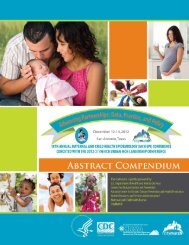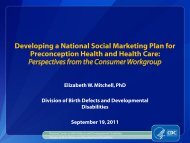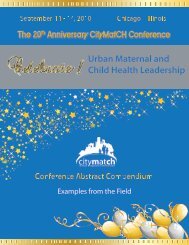Conference Abstract Compendium Examples from the ... - CityMatCH
Conference Abstract Compendium Examples from the ... - CityMatCH
Conference Abstract Compendium Examples from the ... - CityMatCH
You also want an ePaper? Increase the reach of your titles
YUMPU automatically turns print PDFs into web optimized ePapers that Google loves.
2009 <strong>CityMatCH</strong> Urban MCH Leadership <strong>Conference</strong>and IM fell <strong>from</strong> 10.8 per 1,000 live births (95%CI=8.1,14.1) to 8.7 per 1,000 (95%CI=4.9,14.3).In non-NOHS-CA <strong>from</strong> 2004 to 2006, LBW remained stable at 13.1% (95%CI=11.6%,14.7%) and 13.2%(95%CI=11.1%,15.6%), PTB fell <strong>from</strong> 15.9% (95%CI=14.3%,17.6%) to 14.7% (95%CI=12.4%,17.2%),and IM rose <strong>from</strong> 7.3 per 1,000 (95%CI=4.0,12.2) to 10.0 per 1,000 (95%CI=4.6,18.9). It is clear thatNew Orleans has experienced changes since Hurricane Katrina, especially in <strong>the</strong> number of reportedbirths to residents. However, <strong>the</strong>se results fail to show statistically significant differences for <strong>the</strong> birthoutcomes of LBW, PTB, or IM, indicated by overlapping confidence intervals for each area between <strong>the</strong>two time periods 2004 and 2006.LIMITATIONSLack of statistically significant findings may be due to small numbers, evidenced by wide confidenceintervals for many measures. Despite lack of statistical significance, meaningful differences likely exist.Additional years of post-hurricane data would help clarify <strong>the</strong> interpretation of possible changes in birthoutcomes.CONCLUSIONS/IMPLICATIONSOver three years after Hurricane Katrina, <strong>the</strong>re is no statistical evidence that birth outcomes have changedsignificantly in New Orleans, ei<strong>the</strong>r in previously defined high-risk geographical areas or former lowerrisk areas. However, <strong>the</strong> differences reported between <strong>the</strong> two time periods are likely meaningful, despitelack of statistical significance. Programs with targeted geographic reach such as HSNO who use vitalrecords data for program planning after a major disaster may find it difficult to balance apparent changesin birth outcomes with a lack of statistically significant findings. Proper interpretation of data, includingconsideration of sample size issues, is key to effectively guiding future program direction.102







